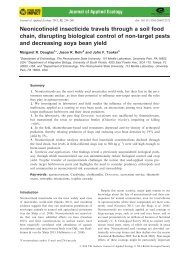Jones-et-al-2014
Jones-et-al-2014
Jones-et-al-2014
You also want an ePaper? Increase the reach of your titles
YUMPU automatically turns print PDFs into web optimized ePapers that Google loves.
This was a preliminary investigation designed to obtain data in a short timesc<strong>al</strong>e. The time<br />
available did not <strong>al</strong>low for the design of a systematic sampling regime taking into account<br />
such factors as soil type. Instead we contacted farmers across Eastern England with whom<br />
we had previously contact and who we believed had used neonicotinoid-treated seed dressing<br />
in recent years. Since the priority was to estimate the range of concentrations across a wide<br />
area, rather than obtain highly accurate measures at each site, and due to the need to obtain<br />
samples quickly, we decided that replication of sites was more important than replication of<br />
sampling within each site. We eventu<strong>al</strong>ly selected 18 sites that were reasonably well spread<br />
across the geographic range of interest. Only two soil samples were to be taken from each<br />
field, to a depth of 10 – 15 cm using a 25 mm diam<strong>et</strong>er corer. One of these was taken from<br />
the main body of the field, the second from an area of field margin, not norm<strong>al</strong>ly in<br />
cultivation. Sampling areas were targ<strong>et</strong>ed to avoid, as far as was possible, veg<strong>et</strong>ation in the<br />
sample. Where possible the “Field Edge” sample was taken down-slope to increase the<br />
likelihood that groundwater from the field had percolated through the area. Fields were<br />
sampled during Spring 2013. Each soil core was transferred to a freezer and stored at<br />
approximately -18 o C prior to an<strong>al</strong>ysis. The farmer was asked to compl<strong>et</strong>e a questionnaire<br />
d<strong>et</strong>ailing application of neonicotinoid seed dressings. Pesticide application records were<br />
collected to supplement the questionnaire when these were readily available.<br />
2.2. Chemic<strong>al</strong> An<strong>al</strong>ysis<br />
Soil samples were thoroughly mixed, a portion (10 g) of each sample was shaken with<br />
m<strong>et</strong>hanol (60 ml) for 1 hour, the mixture was filtered and the volume of the filtrate adjusted<br />
to 100 ml with m<strong>et</strong>hanol. An <strong>al</strong>iquot (2 ml) of this solution was evaporated to dryness and<br />
re-dissolved in m<strong>et</strong>hanol+water (1+9 by volume) prior to an<strong>al</strong>ysis. This solution was<br />
an<strong>al</strong>ysed by liquid chromatography-mass spectrom<strong>et</strong>ry/mass spectrom<strong>et</strong>ry (LC-MS/MS)<br />
using an Agilent 1290 Infinity LC system interfaced to an Agilent 6490 Triple Quad Mass<br />
This article is protected by copyright. All rights reserved




